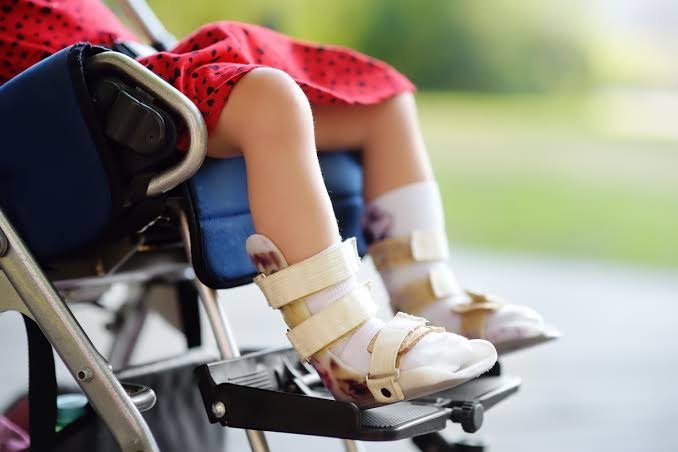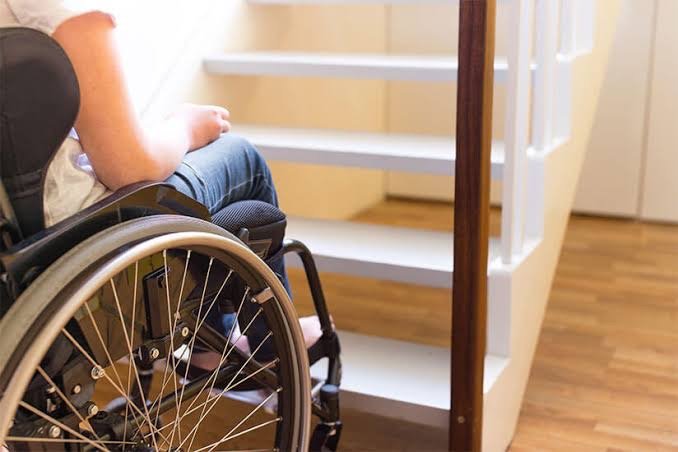
Signs and symptoms appear during infancy or preschool years. In general, cerebral palsy causes impaired movement associated with exaggerated reflexes, floppiness or spasticity of the limbs and trunk, unusual posture, involuntary movements, unsteady walking, or some combination of these.
Symptoms
Movement and coordination
- Stiff muscles and exaggerated reflexes (spasticity), the most common movement disorder
- Variations in muscle tone, such as being either too stiff or too floppy
- Stiff muscles with normal reflexes (rigidity)
- Lack of balance and muscle coordination (ataxia)
- Tremors or jerky involuntary movements
- Slow, writhing movements
- Favoring one side of the body, such as only reaching with one hand or dragging a leg while crawling
- Difficulty walking, such as walking on toes, a crouched gait, a scissors-like gait with knees crossing, a wide gait or an asymmetrical gait
- Difficulty with fine motor skills, such as buttoning clothes or picking up utensils
Speech and eating
- Delays in speech development
- Difficulty speaking
- Difficulty with sucking, chewing or eating
- Excessive drooling or problems with swallowing
Development
- Delays in reaching motor skills milestones, such as sitting up or crawling
- Learning difficulties
- Intellectual disabilities
- Delayed growth, resulting in smaller size than would be expected
Other problems
Damage to the brain can contribute to other neurological problems, such as:
- Seizures (epilepsy)
- Difficulty hearing
- Problems with vision and abnormal eye movements
- Abnormal touch or pain sensations
- Bladder and bowel problems, including constipation and urinary incontinence
- Mental health conditions, such as emotional disorders and behavioral problems
Causes
- Gene mutations that result in genetic disorders or differences in brain development
- Maternal infections that affect the developing fetus
- Fetal stroke, a disruption of blood supply to the developing brain
- Bleeding into the brain in the womb or as a newborn
- Infant infections that cause inflammation in or around the brain
- Traumatic head injury to an infant, such as from a motor vehicle accident, fall or physical abuse
- Lack of oxygen to the brain related to difficult labor or delivery, although birth-related asphyxia is much less commonly a cause than historically thought
Risk factors
A number of factors are associated with an increased risk of cerebral palsy.

Certain infections or toxic exposures during pregnancy can significantly increase cerebral palsy risk to the baby. Inflammation triggered by infection or fever can damage the unborn baby’s developing brain.
- Cytomegalovirus. This common virus causes flu-like symptoms and can lead to birth defects if a mother has her first active infection during pregnancy.
- German measles (rubella).
- Herpes.
- Syphilis.
- Toxoplasmosis.
- Zika virus infection.
- Intrauterine infections.
- Exposure to toxins.
- Other conditions. Thyroid problems, preeclampsia or seizures.
Infant illness
Illnesses in a newborn baby that can greatly increase the risk of cerebral palsy include:
- Bacterial meningitis.
- Viral encephalitis.
- Severe or untreated jaundice.
- Bleeding into the brain.
Factors of pregnancy and birth:
- Low birth weight.
- Multiple babies.
- Premature birth.
- Delivery complications.
Brain scans
Brain-imaging technologies can reveal areas of damage or abnormal development in the brain.
- MRI.
- Cranial ultrasound.
- Electroencephalogram (EEG)

Tests of the blood, urine or skin might be used to screen for genetic or metabolic problems.
Additional tests
- Vision
- Hearing
- Speech
- Intellect
- Development
- Movement
- Other medical conditions
Ayurveda Treatment principles :
- Rajayakshma chikitsa
- Phakka roga chikitsa
- Avarana vata – kaphavrana vata chikitsa
- Dipana – pachana
- Dhatukshaya janya vata chikitsa
- Mastishka visesha chikitsa
- Shiro marmmabhighata chikitsa
- Medhya dravyas
- Balya – brmhana oushadhas
- Mridu or soumya oushadas

- Mirdu swedana
- Udwartanam
- Abhyanga
- Käti basti
- Nasyam
- Pradeha
- Upanaha sweda
- Shiro abhyanga
- Shiro dhara
- Sthanika picchu
- Kashaya dhara
- Kaya seka
- Shashtika shali pinda sweda
- Mrdu & sneha virêcana
- Matra vasti
- Kshira vasti
- Rajayapana vasti
Prevention
- Make sure you’re vaccinated. Getting vaccinated against diseases such as rubella, preferably before getting pregnant, might prevent an infection that could cause fetal brain damage.
- Take care of yourself. The healthier you are heading into a pregnancy, the less likely you’ll be to develop an infection that results in cerebral palsy.
- Seek early and continuous prenatal care. Regular visits to your doctor during your pregnancy are a good way to reduce health risks to you and your unborn baby.
- Avoid alcohol, tobacco and illegal drugs. These have been linked to cerebral palsy risk.
- Rarely, cerebral palsy can be caused by brain damage that occurs in childhood. Practice good general safety. Prevent head injuries by providing your child with a car seat, bicycle helmet, safety rails on the bed and appropriate supervision.
Therapies
A variety of therapies play an important role in treating cerebral palsy:
- Physical therapy. Muscle training and exercises can help your child’s strength, flexibility, balance, motor development and mobility. You’ll also learn how to safely care for your child’s everyday needs at home, such as bathing and feeding your child. Your therapist can provide guidance on how you can continue muscle training and exercise at home between therapy visits.
- Occupational therapy. Occupational therapists work to help your child gain independence in daily activities and routines at home and school and in the community. Adaptive equipment recommended for your child can include walkers, wide-based canes, standing and seating systems, or electric wheelchairs.
- Speech and language therapy. Speech-language pathologists can help improve your child’s ability to speak clearly or to communicate using sign language.
- Recreational therapy. Some children benefit from regular or adaptive recreational or competitive sports, such as therapeutic horseback riding or skiing. This type of therapy can help improve your child’s motor skills, speech and emotional well-being.
Treatment of Cerebral palsy in Ayurdhama Ayurveda:
- After proper consultation individual customized treatments will be planned by our expert doctors.
- Depending upon the condition different types of Ayurveda Panchakarma treatments and internal medicines are advised.
PACKAGE INCLUDES
- Initial Consultation with Ayurveda Doctor and daily follow up consultation
- Accommodation
- All Ayurvedic Meals (Breakfast, Lunch & Supper) & herbal drinks
- Advice on Diet & Lifestyle Management
- Ayurveda Therapies – Customized for each client.
- Yoga (once a day – Yoga Asanas, Breathing, Meditation and Relaxation)
RESERVATION DETAILS:
- We are committed to keep up the quality of our treatment programs and we take only a limited number of patients each month.
- So we advise you to reserve your treatment programs a minimum one month in advance.
- The 50% charges of the treatment programs should be paid in advance to reserve the treatment programs.
- The advance deposit will be deducted from the total treatment programs and the balance must be paid on the first day of the treatment program.


